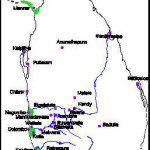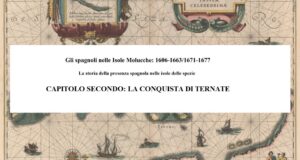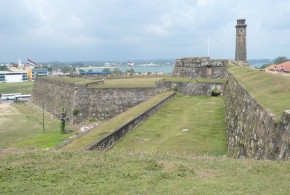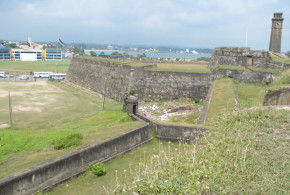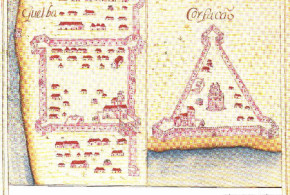This post is also available in:
![]() Français
Français
Written by Marco Ramerini. English text revision by Dietrich Köster.
The first Portuguese visiting Ceylon was Dom Lourenço de Almeida in 1505 or 1506. Accidentally, after a storm, adverse winds drove him to the island’s coast near Galle. In the last months of the years 1505 or 1506 Dom Lourenço’s fleet anchored off Colombo.
A memorial of this first landing was erected on a boulder overlooking the Bay of Colombo. The Portuguese call it a “Padrão”. It is a stone cross displaying the Royal Arms of Portugal. This landmark was still seen in 1920 (Still today?) bearing the inexplicable date of 1501. This first expedition admittedly built a wooden chapel and a factory agency in Colombo. These structures were abandoned a few years later. A treaty was concluded with the King of Ceylon, than residing in the city of Kotte, about two hours by foot from Colombo.
At the time the Island was divided into four Kingdoms: Kotte, the most important, Sitawaka, Kandy in the mountains, and Jaffna in the North.
In 1518 the Viceroy Lopo Soares de Albergaria landed in Colombo with a large fleet. Here the Portuguese began to build a small fort named “Nossa Senhora das Virtudes” or “Santa Bárbara”. This first fort was triangular in shape, surmounted by a central tower. Singhalese soon besieged the fort and around 1524 the Portuguese dismantled it.
The Portuguese kept an agent on the Island under the protection of the Singhalese King at Kotte. Giving up of Colombo was a mistake. The colony of Muslim merchants immediately attempted to win back their supremacy in the Kingdon of Kotte and to regain the cinnamon trade. However, they were to be defeated by the few Portuguese still present on the Island.
The Mappillas (Malabar Muslims), who up to 1539 waged a dynastic conflict in the Kingdoms of Sitavaka and Kotte, opposed the Portuguese presence in Ceylon. Martin Afonso de Sousa would definitely defeat the Mappillas at Vedelai in 1538 and Miguel Ferreira at Negombo in 1539. Also in these years with the encouragement of the King of Kotte, the missionaries began the work of converting the peoples of Ceylon to Christianity. Churches were erected in the fishing village of the southwestern coast. Tragically the King of Jaffna massacred more than 600 Christians on the island of Mannar in 1544. However in 1545 the King of Jaffna submitted and paid tribute to the Portuguese.
In October 1550 the Viceroy Afonso de Noronha arrived in Ceylon with 500 Portuguese soldiers, who occupied Kotte and sacked Sitawaka. But the Viceroy lost a good opportunity of establishing the supremacy of Portugal over the entire island. In November 1554 Duarte de Eça built with 500 soldiers a new fortress in Colombo. By 1556 the communities of fishermen occupying the sea coast south of Colombo (70.000 people) were converted to Christianity. The King of Kotte, Dharmapala (rechristened as Dom João Perya Bandara) and the Queen (rechristened as Dona Catherina) were converted to Christianity. Following the King’s example, a few nobles adopted the Portuguese title of Dom (Sir), the Portuguese manners and language. These conversions were a serious mistake for the King and his entourage, because they alienated the majority of the Singhalese population.
- Portuguese territorial expansion in Ceylon 1560. Author and Copyright Marco Ramerini
- Portuguese territorial expansion in Ceylon 1600. Author and Copyright Marco Ramerini
- Portuguese territorial expansion in Ceylon 1628-1630. Author and Copyright Marco Ramerini
In 1560 Viceroy Dom Constantino de Bragança with 1.200 men conquered the town of Nallur, the capital city of the Kingdom of Jaffna, and soon afterwards the Viceroy proceeded to the island of Mannar where a fort was built. In July 1565 the Portuguese decided to transfer the Court and the capital to Colombo. Thus Kotte was abandoned.
The Portuguese at Colombo were surrounded, because the Singhalese had three strong garrisons around Colombo at Wattala, Nagalagama and Mapane. Only in 1574 the Portuguese took the offensive. They plundered Negombo, Kalutara and Beruwela, drove out the garrisons in Nagalagama and Mapane and ravaged the districts of Weligama and Chilaw. In August 1587 Raja Sinha, the King of Kandy and Sitawaka, began the siege of Colombo. The Portuguese town was protected by fortifications with 12 bastions, which the Singhalese assaulted many times, but always failed. In February 1588 they abandoned the siege.
Till the very end of the XVIIth century the Portuguese were masters of the coast forts of Colombo, Galle, Kalutara and Negombo. In 1591 Andre Furtado de Mendonça invaded Jaffna and nominated a new king at Nallur. The Portuguese occupied Kandy for a brief period in 1592, but after a few weeks they were forced to withdraw. They were also masters of the Kingdoms of Kotte and Sitawaka, but several attempts to occupy Kandy resulted in a failure. In 1597 the Portuguese had begun to fortify Galle.
On 27 May 1597 King Dom João Dharmapala died in Colombo without heirs and in accordance with his will, his Kingdom was donated to the King of Portugal. Thus, as King Philip of the then United Kingdoms of Spain and Portugal was proclaimed King of Ceylon, the whole of the territory of the Kingdom of Kotte was thus under the control of the Portuguese, only Kandy was not yet under Portuguese rule. In 1598 the Portuguese occupied Etgala Tota, which commanded the passage of the river Maha Oya. In 1599 a strong fort was erected at Menikkadawara (Manicavare) at the Kandian’s border.
On 31 May 1602 the first Dutch expedition arrived in Ceylon. They dropped anchor at Batticaloa, a harbor, which the Portuguese had never occupied, and established friendly relations with the King of Kandy against the Portuguese. In January 1603 Dom Jerónimo de Azevedo occupied the fort of Ganetenna and the abandoned fort of Balane, the key to Kandy. However, a few days later he was forced to withdraw and Menikkadawara was also lost.
On 1611, de Azevedo marched with 700 Portuguese and many Lascarins to Kandy, taking also possession of the fort of Balane, where he left a garrison. He was also successful in conquering the city of Kandy, which was taken and burnt. The King of Kandy submitted himself to the Portuguese. Although not destroyed, the Kingdom of Kandy had been neutralized.
In 1624 the Portuguese occupied and fortified Trincomalee. In 1628 Dom Constantino de Sá, after strengthening Menikkadawara, crossed the island and occupied and fortified Batticaloa. During the return march to Colombo he raided Kandy. In 1629 Uva (today Badulla) was also devastated.
In 1630 Dom Constantino de Sá, under pressure from the Viceroy, decided to undertake an expedition against the King Senarat’s capital at Badulla. On 9 August 1630 a small Portuguese army of 400 Portuguese soldiers, 200 Portuguese Casados (married men of the reserve army), and about 4400 Lascarins began the march from Sabaragamwa (near Ratnapura) to Uva across Ceylon’s jungles. On 18 August 1630 the Portuguese entered Badulla, which was found deserted, and sacked and burned the town down for two days. On 21 August 1630 the Portuguese began the march to return to Colombo, but were attacked by the Singhalese army. Most of the Lascarins betrayed – only 500 remained loyal – and joined the enemy. For the Singhalese this was an overwhelming victory: of the Portuguese expedition only 130 men survived and surrendered. This defeat placed Portuguese Ceylon in danger. If the Singhalese had the means of blockading Colombo by sea, the complete destruction of Portuguese power in Ceylon would have been assured. After this victory King Senarat captured the fort of Saparagamuwa and set Colombo under siege. But after three months of siege the Singhalese army was forced to withdraw.
To be continued: The war against the Dutch
- Portuguese territorial expansion in Ceylon 1560. Author and Copyright Marco Ramerini
- Portuguese territorial expansion in Ceylon 1600. Author and Copyright Marco Ramerini
- Portuguese territorial expansion in Ceylon 1628-1630. Author and Copyright Marco Ramerini
- Portuguese and Dutch territorial expansion in Ceylon 1645. Author and Copyright Marco Ramerini
- Portuguese and Dutch territorial expansion in Ceylon 1656. Author and Copyright Marco Ramerini
- Dutch territorial expansion in Ceylon 1658. Author and Copyright Marco Ramerini
- Dutch territorial expansion in Ceylon 1670. Author and Copyright Marco Ramerini
- Dutch territorial expansion in Ceylon 1690. Author and Copyright Marco Ramerini
- Dutch territorial expansion in Ceylon 1766. Author and Copyright Marco Ramerini
LEGEND
- Red: Dutch territory
- Yellow: transitory Dutch conquest 1765-1766.
- Green: Portuguese territory
THE PORTUGUESE GOVERNORS OF CEYLON (Capitão Geral)
Pero Lopes de SOUSA 1594
Dom Jerònimo de AZEVEDO 1594 – 1611
Dom Francisco de MENESES 1611 – 1614
Manuel Homem MASCARENHAS 1614 – 1616
Dom Nuno Alvares PEREIRA 1616 – 1618
Dom Costantino de SA’ e MENENES de NORONHA (first term) 1618 – 1620
Jorge de ALBUQUERQUE 1620 – 1623
Dom Costantino de SA e MENESES de NORONHA (second term) 1623 – 1630
Dom Felipe MASCARENHAS (first term) 1630 – 1631
Dom Jorge de ALMEIDA (first term) 1631 – 1633
Diogo de MELO de CASTRO (first term) 1633 – 1635
Dom Jorge de ALMEIDA (second term) 1635 – 1636
Diogo de MELO de CASTRO (second term) 1636 – 1638
Dom Antonio MASCARENHAS 1638 – 1640
Dom Felipe MASCARENHAS (second term) 1640 – 1645
Manuel Mascarenas HOMEM 1645 – 1653
Francisco de MELO de CASTRO 1653 – 1655
Antonio de Sousa COUTINHO 1655 – 1656
BIBLIOGRAPHY:
– Various Authors “History of Ceylon” Vol. 1, parts 1 & 2: “Pre-Colonial Period” ? University of Ceylon, 1959/60, Colombo, Sri Lanka. Vol. 2: “History of Sri Lanka vol II (1500-1800)” 614 pp. Ed. by K.M. de Silva, University of Peradenya, Ceylon, 1995, Colombo, Sri Lanka.
– Abeyasinghe, T. “Portuguese rule in Ceylon 1594-1612” xi, 247 pp. ills, 3 maps, 2 plates Lake House Investments, 1966, Colombo, Sri Lanka.
– Abeyasinghe, T. “Jaffna under the Portuguese” 66 pp. ill. Lake House, 1966, 1986, Colombo, Sri Lanka.
– Baldaeus, Philip “A Description of the great and most famous Isle of Ceylon” 165 pp. maps, Reprint of the 1703 edition, Asian Educational Services, 1996, New Delhi-Madras, India.
– Bouchon, Geneviéve “A Propos de l’Inscription de Colombo (1501) Quelques Observations sur le Premier Voyage de João da Nova dans l’Ocean Indien” ? In: RUC, vol. XXVIII, pp. 233-270 Universidade de Coimbra, 1980, Coimbra, Portugal.
– Boxer, Ch. R. “Christians and spices: Portuguese missionary methods in Ceylon 1518-1658” ??? In: History Today Vol. VIII, 1958, pp. 346-354
– Brohier, Richard Leslie and Raheem, Ismeth “Changing face of Colombo, 1505-1972 covering the Portuguese, Dutch, and British periods R.L. Brohier. Views of Colombo, 1518-1900” xv+68 pp. 11 maps and ills. 22 plates Lake House Investments, 1984, Colombo, Sri Lanka.
– Buultjens, A. E. “Dom Jerónimo de Azevedo. Governor of Ceylon from 1594 to 1611 A.D.” In: Journal of Royal Asiatic Society (Ceylon) Vol. XV n° 49, 1898 pp.201-212
– Correa, Gaspar “Gaspar Correa’s account of the Portuguese in Ceylon in the first half of the 16th century” In: “Ceylon Literary Register” pp. 179-181
– Coutinho, Xavier “Portugal na história e na arte de Ceilão ” 101 pp. illustrations, separata de STUDIA N° 34-35, 1972, Lisbon, Portugal.
– Faria y Souza “An account of events in Jaffnapatnam (1619-1621)” From: “Ásia Portuguesa” Volume VI, pp. 187-190, pp. 212-217 translated by Dennis Crowder.
– Ferguson, D. W. “The condition of Ceylon under the Governorship of Dom Jerónimo de Azevedo” ??? In: Monthly Register and Notes and Queries for Ceylon IV, 1896, pp. 209-214
– Ferguson, D. W. “The discovery of Ceylon by the Portuguese in 1506” ? In: Journal of the Ceylon Branch of the Royal Asiatic Society, Vol. XIX, 1907, pp. 321-385 and pp. 84-114
– Fernando, C. N. “Christianity in Ceylon in the Portuguese and Dutch period” ??? In: University of Ceylon Review, Vol. VI, 1948, pp. 267-288
– Fitzler, M. A. Hedwig “O cerco de Columbo 1652-1656: últimos dias do domínio Português em Ceilão” ??? xxv + 236 pp. Memórias do Instituto de Coimbra N° 1, Impr. da Universidade, 1928, Coimbra, Portugal.
– Fitzler, M. A. H. “Ceilão e Portugal” ??? xxv, 236 pp. Imprensa da Universidade, 1928, Coimbra, Portugal. English ed. “Ceylon and Portugal: Kings and Christians 1539-1552” ??? Leipzig, 1928
– Flores, J. M. “Os Portugueses e o Mar do Ceilão . Trato, diplomacia e guerra (1498 – 1543)” 368 pp. 2 maps Edições Cosmos 1998 Lisboa, Portugal.
– Goonatilleka, M. H. “Ceilão e Portugal. Relações culturais” In STUDIA N° 30-31, pp. 113 – 161, 1970, Lisbon, Portugal.
– Goonewardena, K.W. “The foundation of Dutch power in Ceylon 1638 – 1658” xx, 196 pp. ills, maps 1958, Amsterdam & Djambatan, NL – Hettiarachchi “Sri Lanka, historical and cultural heritage” Internet article.
– Jackson, Kenneth David “A Presença Oculta: 500 anos de cultura portuguesa na Índia e no Sri Lanka” “A hidden presence: 500 years of Portuguese culture in India and Sri Lanka” Bilingual text: Portuguese and English. 145 pp. CTMCDP, 1995, Macau
– Jones, Randolph “Portuguese soldiers in seventeenth century Ceylon: their dress, weapons, and flags” 10 pp.
– Jones, Randolph “The leopard’s eating place: the battle of Kotikapola, 12 April 1655” 10 pp.
– Lomba, Affonso Dias da; Perera, Simon Gregory “The expedition to Uva made in 1630 by Constantino de Sá e Noronha, Captain-General of Ceylon / as narrated by a soldier who took part in the expedition. Together with: An account of the siege laid to Colombo by the King of Kandy” ? xvi, 101 pp. Government printer, 1930, Colombo
– Lopes, Felix. “A evangelização de Ceilão desde 1552 a 1602” In STUDIA N° 20-22, pp. 7 – 73, 1967, Lisbon, Portugal.
– Mangalarajah, Victor Basil “Jesuit missions in the Kingdom of Jaffnapatão (Jaffna) in Ceylão (Sri Lanka) 1622-1658” ??? 399 pp. Unpublished Ph. D. Thesis, Pontificia Universitas Gregoriana, 1996, Roma, Italy. Published only Chapter 6 of this thesis: “Analysis of the Apostolate as an ongoing process in the Jaffna Kingdom” 144 pp. Excerpta ex dissertatione ad Doctoratum in Facultate Historie Ecclesiasticae Pontificie Universitatis Gregorianae, 1996, Roma
– Pearson, J. “Notes on the forts of the Jaffna islands” In: JRASC Vol. XXIX n° 76, 1923 pp. 186-193
– Perniola V. “The Catholic Church in Sri Lanka: the Portuguese period” vol I 1505-1565 xxx+474 pp. Tisakara Prakasakayo, 1989, Dehiwala, Sri Lanka. vol II 1566-1619 xxv+487 pp. Tisakara Prakasakayo, 1991, Dehiwala, Sri Lanka. vol III 1620-1658 xxx+410 pp. Tisakara Prakasakayo, 1991, Dehiwala, Sri Lanka.
– Peter, W. L. A. Don “The Catholic Church in Sri Lanka: a history in outline” Catholic Communication, 1996, Colombo, Sri Lanka.
– Peter, W. L. A. Don “Education in Sri Lanka under the Portuguese” ??? 342 pp. The Colombo Catholic Press, 1978, Colombo, Sri Lanka.
– Pieris, P. E. “Ceylon and the Portuguese 1505 – 1658” 290 pp. 3 maps, American Ceylon Press, 1920 Colombo, Sri Lanka. New edition:Sri Satguru Publ. 1986, Delhi, India.
– Pieris, P. E. “Ceylon: the Portuguese era” Vol. I (1505-1616) 590 pp. Maps & ills. Ceylon Aphotecaries Co., 1913, Colombo, Sri Lanka. Vol. II (1616-1658) 461 pp Tisara Prakasakayo, 1983, Colombo, Sri Lanka.
– Pieris, P. E. “The Kingdom of Jaffnapatam, 1645” 67 pp. 1920 An account of its Administration Organisation as derived from the Portuguese Archives.
– Pieris, P. E. “Ribeiro’s History of Ceilão. With a Summary of de Barros, de Couto, António Bocarro and the Documentos Remetidos, with the Parangi Hatane and Kostantinu Hatane” ? xvii, (iii), 416 pp., The Colombo Apothecaries Co. N.p. 1909, Colombo, Ceylon.
– Quéré, Martin, “Christianity in Sri Lanka under the Portuguese padroado, 1597-1658” xii, 298 pp. maps Colombo Catholic Press, 1995, Colombo, Sri Lanka.
– Queyroz, Fernão de “The temporal and spiritual conquest of Ceylon” Translator: Perera, S. G. 1274 pp. 3 Volumes 1930 (Reprint 1992, Asian Educational Services, New Delhi & Madras)
– Remco, Raben “Trade and urbanization: Portuguese and Dutch urban attitudes in Ceylon. Colombo: mirror of colonial mind” In: Mare Liberum, Revista de História dos Mares Nº 13 , pp. 95-117, 1997, Lisbon, Portugal.
– Ribeiro “The historic tragedy of the island of Ceylon” 266 pp. Asian Educational Services, 1999, New Delhi-Madras, India.
– Sa, Costantine “Constantine de Sá’s maps and plans of Ceylon 1624-1628” vi+66 pp. maps Translated by Reimers, E. 1929, Colombo.
– Silva, Ch. R. de “The Portuguese in Ceylon 1617-1638” 267 pp H. W. Cave & Company 1972 Colombo.
– Silva , Ch. R. de “Lançarote de Seixas and Madampe: a Portuguese Casado in a Singhalese village” In: Modern Ceylon Studies Vol. II, 1970, pp. 24-38 map.
– Silva , Ch. R. de “The Portuguese impact on the production and trade in Sri Lanka cinnamon in: Asia in the Sixteenth and Seventeenth Centuries” In: “An Expanding World” Vol. n° 11; Pearson, M. N. “Spice in the Indian Ocean world” Ashgate Variorum, vol. n° 11, 1996; pp. 245-258 In: Indica, Vol. 26, N° 1, March 1989, pp. 25-38
– Silva Jayasuriya, Shinhan de “The Portuguese cultural imprint on Sri Lanka” In: “Lusotopie 2000” pp. 253-259
– Silva, O. M. da “Vikrama Bahu of Kandy: the Portuguese and the Franciscans, 1542-1551” xv, 110 pp. illus., map, M. D. Gunasena & Co. Ltd, 1967, Colombo, Sri Lanka.
– Silva , O. M. Cosme da “Fidalgos in the kingdom of Kotte, Sri Lanka, 1505-1656: the Portuguese in Sri Lanka” ??? xvi, 621 pp. ill, map, Harwoods Publishers, 1990, Colombo, Sri Lanka.
– Silva, O. M. Cosme da “António Bocarro’s 17th century Sri Lanka: 1614-1617” ? xxii + 94 pp. Harwoods Publishers, 1998, Colombo, Sri Lanka
– Silva, O. M. Cosme da “Fidalgos in the kingdom of Jaffnapatam 1543-1658: the Portuguese in Jaffna” 136 pp. Harwoods Publishers, 1994, Colombo, Sri Lanka.
– Trindade, Paulo da, “Conquista Espiritual do Oriente, em que se dá relação de algumas cousas mais notáveis que fizeram os frades menores da santa província de S. Tomé da Índia Oriental” Chapters 1 to 56 of vol. III are about Ceylon history. The chapters on Ceylon were translated by E. Peiris and A. Meersman “Early Christianity in Ceylon: Chapters on Introduction of Christianity to Ceylon” 1972, Chilaw, Ceylon.
– Winius,G. D. “Fatal history of Portuguese Ceylon: transition to Dutch rule” 215 pp. 2 maps Harvard University Press 1971 Cambridge, Massachusetts USA From: “The Fall of Portuguese Ceylon 1638-1656: military, diplomatic and political aspects in the decline of an empire” 242 pp. Ph. D. Thesis Columbia University, 1964
This post is also available in:
![]() Français
Français
 Colonial Voyage The website dedicated to the Colonial History
Colonial Voyage The website dedicated to the Colonial History
